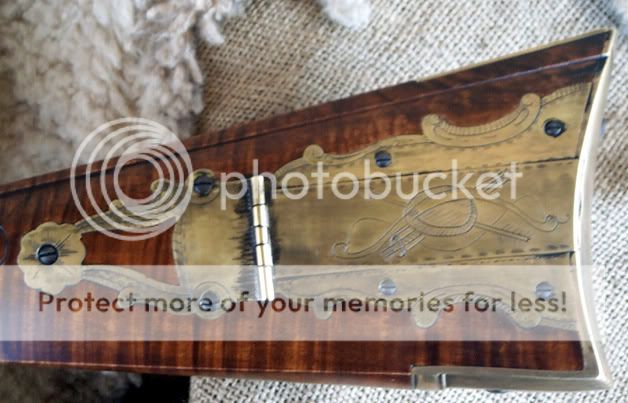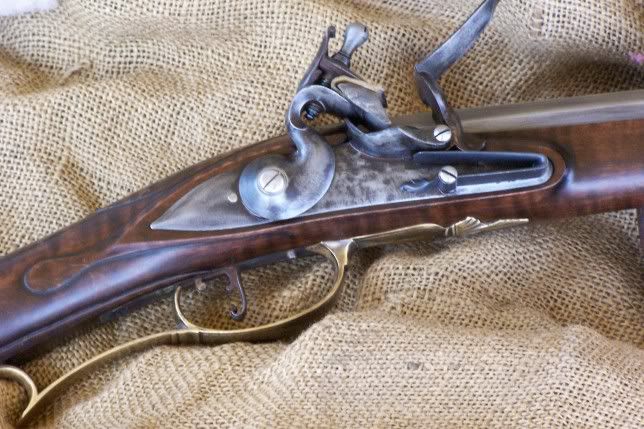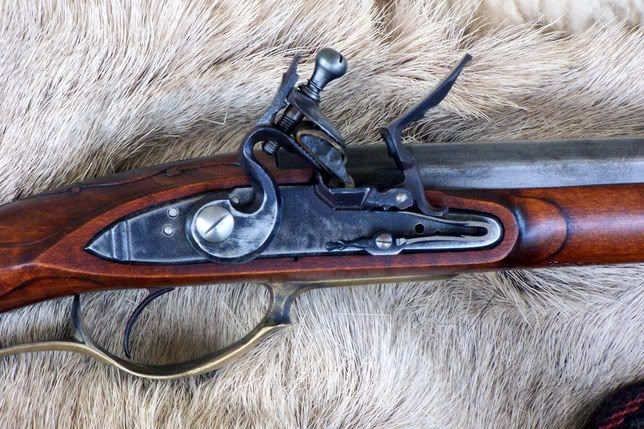I would add some marine spar varinish to the linseed oil for the finish, with a touch of mineral spirits, this will give a much better and more durable finish, put on one coat, wipe down after an hour then repeat three or four times.
You are using an out of date browser. It may not display this or other websites correctly.
You should upgrade or use an alternative browser.
You should upgrade or use an alternative browser.
how to make a newer rifle look old
- Thread starter Brasilikilt
- Start date

Help Support Muzzleloading Forum:
This site may earn a commission from merchant affiliate
links, including eBay, Amazon, and others.
Yep, so did many of the old varishes. Those experts, who have studied 18th and early 19th centry guns closely, report that many gunsmiths often added a redish under stain and seal coat of shellac prior to the final oil varish finish.
Some of those researchers claim that many old guns have been stained with as many as three different colors, one over the other, to give a pleasing color to the finished piece.
J.D.
Some of those researchers claim that many old guns have been stained with as many as three different colors, one over the other, to give a pleasing color to the finished piece.
J.D.
You will not tell the difference in appearence between the finish with or without the spar varnish. I have used both methods on many guns, the spar varnish just adds some real protection, prevents the gummy syndrome,and is probably quite close to some of the original finishes
Many Klatch
69 Cal.
- Joined
- May 19, 2006
- Messages
- 3,498
- Reaction score
- 269
If you are going to do Linseed oil let me give a few tips. First mix the linseed oil this way
3 parts linseed oil
1 part vinegar
1 part turpentine
Shake it before each use. Be careful of the rag, it will spontaneously combust if you leave it out in the air. I always stuff mine tightly into a small mason jar with hardly any air space left, then screw the lid down tight.
The linseed oil of history was "Sun Boiled" ie. left out in shallow pans in the sun. The action of the sun broke the wax down (or at least that is what I was told). So the boiled linseed of today is waxier than the BLO of history. The turp and vinegar will break the waxes down.
Rub the linseed oil mix in according to this recipe:
Once an hour for a day
Once a day for a week
Once a week for a month
Once a month for a year
This will put a deep finish on your stock that will protect the wood.
By the way, the linseed oil mix also works great on antique furniture.
3 parts linseed oil
1 part vinegar
1 part turpentine
Shake it before each use. Be careful of the rag, it will spontaneously combust if you leave it out in the air. I always stuff mine tightly into a small mason jar with hardly any air space left, then screw the lid down tight.
The linseed oil of history was "Sun Boiled" ie. left out in shallow pans in the sun. The action of the sun broke the wax down (or at least that is what I was told). So the boiled linseed of today is waxier than the BLO of history. The turp and vinegar will break the waxes down.
Rub the linseed oil mix in according to this recipe:
Once an hour for a day
Once a day for a week
Once a week for a month
Once a month for a year
This will put a deep finish on your stock that will protect the wood.
By the way, the linseed oil mix also works great on antique furniture.
Many Klatch's recipie reminded me on one I saw some time ago. It took a while to find it, and it's the same as tg's recipie, but with a little more detail.
Equal parts of turpentine, thickened linseed oil, and good marine grade spar varnish. That is obviously a wipe on to be rubbed out with steel wool or other fine abrasive.
J.D.
Equal parts of turpentine, thickened linseed oil, and good marine grade spar varnish. That is obviously a wipe on to be rubbed out with steel wool or other fine abrasive.
J.D.
As far as the brass being "Antiqued" I've had good results using common household items. I can achieve different results with time and amount of solution used. First is an even wash allowed to sit overnight.

These other's are more of a direct application again allowed to sit overnight. This results in an almost case-hardened like appearance to the brass.


On both the Underhammer (first pic) & the Hawken, the brass was bright and shiney when I got them (didn't like the way it looked "to new")
Et2ss

These other's are more of a direct application again allowed to sit overnight. This results in an almost case-hardened like appearance to the brass.


On both the Underhammer (first pic) & the Hawken, the brass was bright and shiney when I got them (didn't like the way it looked "to new")
Et2ss
Brasilikilt said:Hello everyone
I got myself a can of "Kleen Strip" yesterday and sprayed a little on the butt of my .50 Spanish Hawken......just as I was told, it took that ugly dinged-up clear coat off.
Tomorrow I'll take the barrel, the lock and whatever metal I can easily remove and do the rest of the stock.
The game plan I have going is to use fine sandpaper and steel wool to get the stock nice and smooth and then rub a ton of linseed oil in the wood.
I think that this will do a lot to "de-cheese-ify" the appearance of the rifle.
I would love to make this rifle look like it's been kicked around the mountains for a while.
What do you guys do to give a rifle a stressed and aged appearance?
If I'm feeling bold enough, I might even brown the lock and barrel in the future.....
thanks for any help
Iain
I've always wanted to try that myself....creat a gun that looked used, not beaten to death, but old with grime, a few dents, handling marks....wellll, that opportunity came around.
Here's a few pics:





Is this something that you want to do?
DrTimboone
40 Cal.
- Joined
- Jan 3, 2005
- Messages
- 390
- Reaction score
- 3
Did you set it in the barn over the winter and a humid summer?? :rotf:
It looks used!! :thumbsup:
It looks used!! :thumbsup:
DrTimboone
40 Cal.
- Joined
- Jan 3, 2005
- Messages
- 390
- Reaction score
- 3
So ET2ss,
What were the common household chemicals you used to get this fine coloring? :thumbsup:
What were the common household chemicals you used to get this fine coloring? :thumbsup:
As I was making the rifle, there appeared these very small holes that were elongated: worm holes...DRAT! I then decided to take advantage of them.
I finish sanded the rifle, then took the barrel and sanded the sharp edges off the barrel. I gave it a quick bleach bath, washed it down with water, dried it then took a toothbrush and flicked both cold blueing and browning on it. After that I then took blue/rust remover and flicked that onto the barrel. Then I let it sit outside for a few days in the rain.
I did the same to the lock.
The brass I heated up and dribbled cold blue on it and it stained it as you see it.
I then assembled the rifle and stained it with some alcohol based stains, dark brown color steel wooled off followed by a golden brown color. I oiled it as I normally would then steel wooled it off. I used a heavy dose of True-oil for this.
Then I went ouside and dropped all sorts of things on the gun: chains, hammers, bricks, rocks and I liberally tossed it up and down a few times in my gravel drive.
Now the dings and dents were there, so I applied a darker stain. When dry, I took some steel wool and buffed it down in areas that I would normally grab the gun: the wrist and behind the ramrod entry. I also used some very worn sandpaper to highlight the cheeck area, around the lock and the side plate. I also removed as much stain from the wrist and just front of the lock are with sandpaper.
I then took some black leather dye, and acid brush for soldering, and blotted some of this on the very end of the butt and some other spots, dabbing it here and there, then blotting with a tissue.
Then I oiled it.
I want it to look like it has been used, not beaten and destroyed.
I think I did ok.
I finish sanded the rifle, then took the barrel and sanded the sharp edges off the barrel. I gave it a quick bleach bath, washed it down with water, dried it then took a toothbrush and flicked both cold blueing and browning on it. After that I then took blue/rust remover and flicked that onto the barrel. Then I let it sit outside for a few days in the rain.
I did the same to the lock.
The brass I heated up and dribbled cold blue on it and it stained it as you see it.
I then assembled the rifle and stained it with some alcohol based stains, dark brown color steel wooled off followed by a golden brown color. I oiled it as I normally would then steel wooled it off. I used a heavy dose of True-oil for this.
Then I went ouside and dropped all sorts of things on the gun: chains, hammers, bricks, rocks and I liberally tossed it up and down a few times in my gravel drive.
Now the dings and dents were there, so I applied a darker stain. When dry, I took some steel wool and buffed it down in areas that I would normally grab the gun: the wrist and behind the ramrod entry. I also used some very worn sandpaper to highlight the cheeck area, around the lock and the side plate. I also removed as much stain from the wrist and just front of the lock are with sandpaper.
I then took some black leather dye, and acid brush for soldering, and blotted some of this on the very end of the butt and some other spots, dabbing it here and there, then blotting with a tissue.
Then I oiled it.
I want it to look like it has been used, not beaten and destroyed.
I think I did ok.
I love it! Your description of how you did it would make a great chapter in one of the gunbuilding books (and a brilliant video sequence, especially throwing stuff on it).
There's a lot to be said for having a gun like yours that not only looks great but also is something you don't have to worry about dinging and denting every time you take it out.
There's a lot to be said for having a gun like yours that not only looks great but also is something you don't have to worry about dinging and denting every time you take it out.
This complex solution takes great care in mixing as not to harm ones self :winking:
I used a heated measure of Dihydroxy Monoxide, and then disolved as much sodium bicarbonate into it until it can no longer dissolve any more. (OK, OK Hot Water& Baking Soda) then a touch of dish soap (to break up the surface tension) On the hawken after wiping on the solution with a paper towel, I gathered up the sediment at the bottom of the container & caked it onto the brass. I then set in on a plate in my garage (for humidity) and left it overnight. In the AM when I washed it off I was quite pleased with the results.
I used a heated measure of Dihydroxy Monoxide, and then disolved as much sodium bicarbonate into it until it can no longer dissolve any more. (OK, OK Hot Water& Baking Soda) then a touch of dish soap (to break up the surface tension) On the hawken after wiping on the solution with a paper towel, I gathered up the sediment at the bottom of the container & caked it onto the brass. I then set in on a plate in my garage (for humidity) and left it overnight. In the AM when I washed it off I was quite pleased with the results.
Halftail said:Why Couldn't we just beat it with a chain then drive over it with a truck? :hmm:
Because your Firestone Tires aren't PC. :blah:
- Joined
- Jan 12, 2005
- Messages
- 1,245
- Reaction score
- 1,681
I use a combination of the Allen Martin method for the metal parts, BC Brass Black for the brass and Rustoleum flat black on the finish.
Gives a nice patina to all the parts.



Gives a nice patina to all the parts.



I think this is the look you are striving for - check out his multiple index of photos.
Eric Kettenburg rifles
Eric Kettenburg rifles
Similar threads
- Replies
- 6
- Views
- 475
- Replies
- 5
- Views
- 271
- Replies
- 31
- Views
- 1K
- Replies
- 31
- Views
- 2K
- Replies
- 3
- Views
- 549




